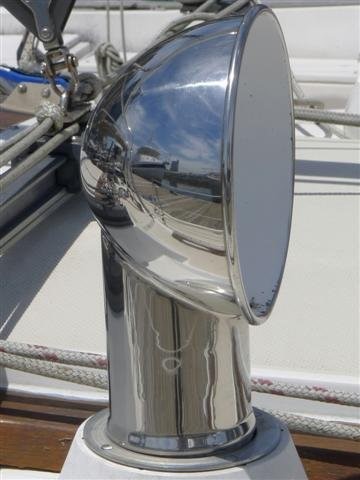
Why Ventilate your Boat?
Based on an article by BoatUS
Unattended boats generate humidity and moisture below because of water, air, and hull surface temperatures that are never identical and always changing. While true even in a "dry" climate, this process accelerates in a humid climate and in cold water.
When you ventilate your boat, you want to do more than simply move air — you want to equalize the humidity levels inside and outside the boat, including areas between hulls, behind paneling and other enclosed areas that you don't normally see. When you close off your boat's cabin to "protect" it from humidity, you may actually cause the humidity level below deck to rise. And no matter where your boat is docked, humidity and temperature levels vary, and there is a differential between air temperature and water temperature that's constantly changing.
When there is a difference in temperature, moisture forms. You see this happen in a rainstorm, when a hot air mass and a cold air mass meet, reducing the humidity in the atmosphere into water, or rain. Although not as extreme, the same phenomenon is constantly taking place on your boat, due to the temperature difference between the cabin (which is affected by water temperature and heat build-up during the day) and the air temperature outside. It is that humidity (or condensation) in the cabin that will do the most damage.
How Much Ventilation is Required for Your Boat?
Ideally, the air in the interior of a boat should be circulated once every hour. A typical 30' boat contains approximately 800 cu. ft. of air. The general guidelines for providing maintenance ventilation for living areas are outlined in the chart below.
Boat Size Recommended Ventilation
|
Boat Size
|
Recommended Ventilation
|
|
Up to 24'
|
1 Exhaust Vent*
|
|
24'-40'
|
1 Exhaust Vent & 1 Intake Vent
|
|
40'+
|
2 Exhaust Vents & 1 Intake Vent
|
|
*One vent assumes there will be access for air to get into the cabin (i.e., cowl vent, clamshell vent, or louvered panel.)
|
To specifically calculate your boat's air volume, use this simple formula:
A x B x C x 70% = Boat Interior Volume
A = The interior length (excluding cockpit)
B = The boat's width
C = The average interior height
.
Don't overlook enclosed spaces mentioned at the beginning. Unless you have a better method for ventilating these spaces, open drawers and cabinets and other access panels below deck when you leave the boat.
Always beware of the risk of and take caution concerning induction of harmful fumes, exhaust or otherwise. For example, if a boat nearby is running its engine and/or generator, odorless but lethal carbon monoxide may be present in sufficient quantity to be taken into any vents, and capable of causing death. Also, far too many deaths have occurred caused by onboard generator or engine fumes finding their way inside living areas through vents.
Always keep in mind the likelihood of boarding seas, driving rain and other water intrusion when installing vents. Dorade vents can be quite helpful as passive vents forward. If properly designed and installed, water which finds its way into the vent scoop "pipe" is prevented from going below by a built in dam inside the vent box and the water drains out holes in the side of the box (unless you take on too much water). With these vents you can also rotate the vent pipe so that it sucks air out and remove it altogether, covering the hole with a plate when expecting bad weather. Don't install vents where people will be walking or in a manner that will allow them to become broken while docking or in other activity.